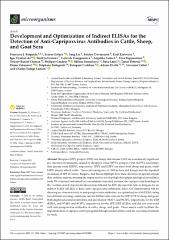Development and Optimization of Indirect ELISAs for the Detection of Anti-Capripoxvirus Antibodies in Cattle, Sheep, and Goat Sera

View/
Date
2022Author
Berguido, Francisco J.
Gelaye, Esayas
Liu, Yang
Davaasuren, Batdorj
Krstevski, Kiril
Djadjovski, Igor
Ivanova, Emiliya
Goujgoulova, Gabriela
Loitsch, Angelika
Tuppurainen, Eeva
Chibssa, Tesfaye Rufael
Caufour, Philippe
Samojlović, Milena
Lazić, Sava
Petrović, Tamaš
Vidanović, Dejan
Bertagnoli, Stéphane
Grabherr, Reingard
Diallo, Adama
Cattoli, Giovanni
Lamien, Charles Euloge
Metadata
Show full item recordAbstract
Sheeppox (SPP), goatpox (GTP), and lumpy skin disease (LSD) are economically significant
pox diseases of ruminants, caused by sheeppox virus (SPPV), goatpox virus (GTPV), and lumpy
skin disease virus (LSDV), respectively. SPPV and GTPV can infect both sheep and goats, while
LSDV mainly affects cattle. The recent emergence of LSD in Asia and Europe and the repeated
incursions of SPP in Greece, Bulgaria, and Russia highlight how these diseases can spread outside
their endemic regions, stressing the urgent need to develop high-throughput serological surveillance
tools. We expressed and tested two recombinant truncated proteins, the capripoxvirus homologs of
the vaccinia virus C-type lectin-like protein A34 and the EEV glycoprotein A36, as antigens for an
indirect ELISA (iELISA) to detect anti-capripoxvirus antibodies. Since A34 outperformed A36 by
showing no cross-reactivity to anti-parapoxvirus antibodies, we optimized an A34 iELISA using
two different working conditions, one for LSD in cattle and one for SPP/GTP in sheep and goats.
Both displayed sound sensitivities and specificities: 98.81% and 98.72%, respectively, for the LSD
iELISA, and 97.68% and 95.35%, respectively, for the SPP/GTP iELISA, and did not cross-react
with anti-parapoxvirus antibodies of cattle, sheep, and goats. These assays could facilitate the
implementation of capripox control programs through serosurveillance and the screening of animals
for trade.
